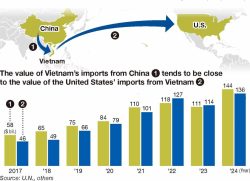Govt to Launch Searchable Database of Budget Projects; Japan Project Aims to Boost Transparency, Efficiency

The Prime Minister’s Office in Tokyo
6:00 JST, April 26, 2024
The government will create an easily searchable database of all of the nation’s about 5,000 budget projects and make the information publicly available on a website as early as September, a move aimed at increasing the transparency of these projects.
Each project will be assigned a unique number, which will enable the public to easily check details such as where funding is being channeled and how much of the budget has been spent. This greater transparency will make it easier to analyze data and compare projects with previous projects, which the government hopes will reduce waste and improve the efficiency of budget spending.
In the fiscal year that began on April 1, the Cabinet Secretariat’s Headquarters for the Promotion of Administrative Reform has started work on a database for administrative project review sheets, which check for budget wastage. Each ministry and agency completes a review sheet for each project, which includes details such as the project’s name, an overview, the budget amount and how much has been spent. The database will cover every project conducted since fiscal 2021.
Information on the new website will be based on this database, which the government plans to enhance with a search function. Users will be able to search for the desired project by entering keywords or budget size. The government also is considering using graphs to visually depict the budget expenditures of individual ministries, agencies and departments in charge of projects.
Until now, government ministries and agencies have released review sheets outlining all their budget projects on their websites each fiscal year. The administrative reform headquarters also has released a list of these projects using the Excel spreadsheet program. However, getting a grasp on ongoing projects was difficult under both methods, with some search attempts coming up empty due to text discrepancies such as certain items being written in full-width characters while others were in half-width characters.
To eliminate these problems, a uniform writing standard will be adopted to prepare for the launch of the database, and each project will be given a unique six-digit number. This number will not change even if a project continues beyond a single fiscal year. As a result, a project can be searched for by number even if it is renamed and users can easily detect any changes that occur over a period of years.
The government is pushing ahead with evidence-based policymaking and will also promote greater transparency in budget projects. There are expectations that the visualization of similar projects being conducted by multiple government ministries and agencies will lead to more efficient budget compilation and implementation.
The government’s conventional budget compilation process involves each ministry and agency submitting appropriation requests by the end of August each year. The Finance Ministry then examines these requests and the cabinet approves the budget at year-end. By making the website available in September, the government intends to reflect the figures in the compilation of the budget for fiscal 2025, which starts in April next year.
"Politics" POPULAR ARTICLE
-

Japan, India Aim for More Than 500,000 People-to People Exchanges over Next 5 Years
-

Japan to Provide ¥810 Billion in Infrastructure Aid to African Nations, Seeks to Reduce China’s Influence in Continent
-

Chief of Japan’s SDF Logistics Unit in Djibouti Vows to Assist Japanese Nationals in Emergencies, Stresses Need to Prepare for Protecting Citizens
-

Japan-South Korea Agreement Reflects Shared Understanding
-

Remote Japan Island near Taiwan Struggles to Secure Doctor Amid Fear of Taiwan Contingency
JN ACCESS RANKING
-

Japan’s Seafood Exports Still Hurting in Wake of Fukushima Incident, but Hopes Rising for Chinese Market
-

Japan’s Core Inflation Slows in July, Stays above BOJ Target
-

Japan in Prime Spot for Total Lunar Eclipse Early Monday Morning, 1st Visible from Country in Almost 3 Years
-

Japan, India Aim for More Than 500,000 People-to People Exchanges over Next 5 Years
-

S. Korea’s Lee Eager to Enhance Ties with Japan More





















